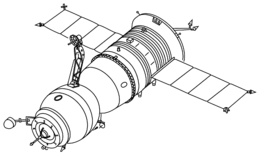
The Soyuz programme is a human spaceflight programme initiated by the Soviet Union in the early 1960s. The Soyuz spacecraft was originally part of a Moon landing project intended to put a Soviet cosmonaut on the Moon. It was the third Soviet human spaceflight programme after the Vostok (1961–1963) and Voskhod (1964–1965) programmes.
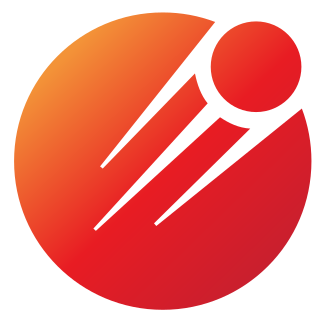
PAO S. P. Korolev Rocket and Space Corporation Energia, also known as RSC Energia, is a Russian manufacturer of spacecraft and space station components. The company is the prime developer and contractor of the Russian crewed spaceflight program; it also owns a majority of Sea Launch. Its name is derived from Sergei Korolev, the first chief of its design bureau, and the Russian word for energy.

Zond 8, also known as L-1 No.14, was the last in the series of circumlunar spacecraft, a member of the Soviet Zond program, designed to rehearse a piloted circumlunar flight, an uncrewed version of Soyuz 7K-L1 crewed circumlunar flight spacecraft. The project was initiated in 1965 to compete with the Americans in the race to the Moon but lost its importance once three astronauts orbited the Moon on the Apollo 8 mission in December 1968.

Soyuz 3 was a spaceflight mission launched by the Soviet Union on 26 October 1968. Flown by Georgy Beregovoy, the Soyuz 7K-OK spacecraft completed 81 orbits over four days. The 47-year-old Beregovoy was a decorated World War II flying ace and the oldest person to go into orbit up to that time. The mission achieved the first Russian space rendezvous with the uncrewed Soyuz 2, but failed to achieve a planned docking of the two craft.
Human spaceflight programs have been conducted, started, or planned by multiple countries and companies. Until the 21st century, human spaceflight programs were sponsored exclusively by governments, through either the military or civilian space agencies. With the launch of the privately funded SpaceShipOne in 2004, a new category of human spaceflight programs – commercial human spaceflight – arrived. By the end of 2022, three countries and one private company (SpaceX) had successfully launched humans to Earth orbit, and two private companies had launched humans on a suborbital trajectory.

The N1/L3 was a super heavy-lift launch vehicle intended to deliver payloads beyond low Earth orbit. The N1 was the Soviet counterpart to the US Saturn V and was intended to enable crewed travel to the Moon and beyond, with studies beginning as early as 1959. Its first stage, Block A, was the most powerful rocket stage ever flown for over 50 years, generating 45.4 MN of thrust. However, each of the four attempts to launch an N1 failed in flight, with the second attempt resulting in the vehicle crashing back onto its launch pad shortly after liftoff. Adverse characteristics of the large cluster of thirty engines and its complex fuel and oxidizer feeder systems were not revealed earlier in development because static test firings had not been conducted.
The Soviet-crewed lunar programs were a series of programs pursued by the Soviet Union to land humans on the Moon, in competition with the United States Apollo program. The Soviet government publicly denied participating in such a competition, but secretly pursued two programs in the 1960s: crewed lunar flyby missions using Soyuz 7K-L1 (Zond) spacecraft launched with the Proton-K rocket, and a crewed lunar landing using Soyuz 7K-LOK and LK spacecraft launched with the N1 rocket. Following the dual American successes of the first crewed lunar orbit on 24–25 December 1968 and the first Moon landing on July 20, 1969, and a series of catastrophic N1 failures, both Soviet programs were eventually brought to an end. The Proton-based Zond program was canceled in 1970, and the N1-L3 program was de facto terminated in 1974 and officially canceled in 1976. Details of both Soviet programs were kept secret until 1990 when the government allowed them to be published under the policy of glasnost.

The LK was a lunar module developed in the 1960s as a part of several Soviet crewed lunar programs. Its role was analogous to the American Apollo Lunar Module (LM). Three LK modules, of the T2K variant, were flown without crew in Earth orbit, but no LK ever reached the Moon. The development of the N1 launch vehicle required for the lunar flight suffered setbacks, and the first Moon landings were achieved by US astronauts on Apollo 11. As a result, having lost the Space Race, both the N1 and the LK programs were cancelled without any further development.

Soyuz 7K-OK was the first generation of Soyuz spacecraft and was flown between 1967 and 1971. The 7K-OK was used for the first ferry flights to the Salyut space station program, beginning a long history of space station service that continues today with the International Space Station (ISS).
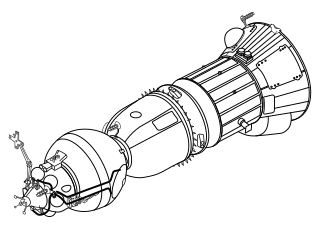
The Soyuz 7K-LOK, or simply LOK was a Soviet crewed spacecraft designed to take humans from Earth to orbit the Moon, developed in parallel to the 7K-L1. The LOK would carry two cosmonauts, acting as a mother ship for the LK Lander which would land one crew member to the surface. It was part of the N1-L3 programme which also included the LK lander and the N1 rocket.

The Soyuz 7K-L1 "Zond" spacecraft was designed to launch cosmonauts from the Earth to circle the Moon without going into lunar orbit in the context of the Soviet crewed Moon-flyby program in the Moon race. It was based on the Soyuz 7K-OK. Several modifications reduced vehicle mass and increased circumlunar capability. The most notable modifications were the replacement of the orbital module with a support cone and a high-gain parabolic antenna, the removal of a reserve parachute, and the addition of the gyro platform and star navigation sensors for the far space navigation. The spacecraft was capable of carrying two cosmonauts. At the start of flight testing, there were serious reliability problems with the new Proton rocket, the 7K-L1, and the Soyuz 7K-OK that the L1 was based on.
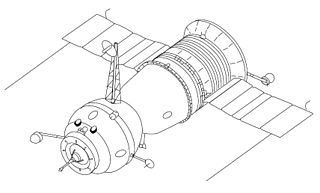
Soyuz 7K-OKS is a version of the Soyuz spacecraft and was the first spacecraft designed for space station flights. Its only crewed flights were conducted in 1971, with Soyuz 10 and Soyuz 11.

The Soviet Union planned several military Soyuz spacecraft models. These versions were named Soyuz P, Soyuz PPK, Soyuz R, Soyuz 7K-VI, and Soyuz OIS (Orbital Research Station). However, none of the spacecraft ever flew in space.
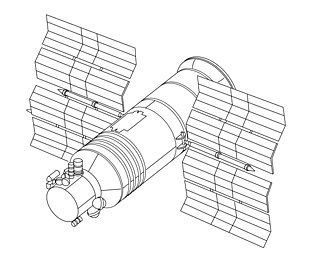
Gamma was a Soviet gamma ray telescope. It was launched on 11 July 1990 into an orbit around Earth with a height of 375 km and an inclination of 51.6 degrees. It lasted for around 2 years. On board the mission were three telescopes, all of which could be pointed at the same source. The project was a joint Soviet-French project.
Zond program was a Soviet robotic spacecraft program launched between 1964 and 1970, using two spacecraft series, one for interplanetary exploration, and the other for lunar exploration.

Soyuz 7K-L1E was a Soviet uncrewed modified Soyuz 7K-L1 spacecraft. Also called a dummy Soyuz 7K-LOK. Two were built, one Soyuz 7K-L1E was successfully launched into Low Earth Orbit on Proton rocket and is known as Kosmos 382. The other Soyuz 7K-L1E was placed on a N1 rocket, which failed at launch. The Soyuz spacecraft was first used in 1967 as the main crewed spacecraft and is still in use. Many Soyuz variations have been built and the Soyuz 7K-L1E was an uncrewed variation.
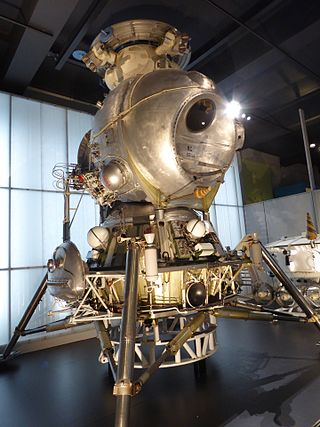
Soyuz Kontakt(Soyuz Contact) was the docking hardware of the Soviet crewed lunar spacecraft program. The Soviet lunar human program was canceled in 1974 after many failures. Four failures of the N-1 Rocket super heavy-lift launch vehicle and the success of the U.S. Apollo program ended the Soviet crewed moon program.

Soyuz 7K-T-AF is a version of the Soyuz spacecraft and was the first spacecraft designed for space station flights, a dedicated science mission. Its only crewed flight was conducted in 1973 with Soyuz 13 of the Soyuz programme.

Soyuz 7K-MF6 is a version of the Soyuz spacecraft and was the second Soviet spacecraft designed for space station flight, a dedicated science mission. Its only crewed flight was conducted in 1976 with Soyuz 22 of the Soyuz programme.
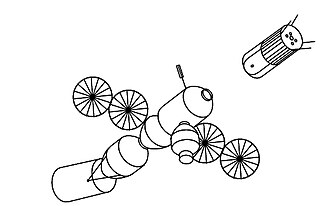
Soyuz Sever, also spelled Soyuz Siber,, was an early (1959–1962) design of the Soyuz spacecraft. The Soyuz Sever design of a crewed spacecraft started the Soyuz programme. In 1956, the Soyuz Sever spacecraft was proposed as the replacement for the Vostok spacecraft. Vostok spacecraft had only a crew of one; the Soyuz Sever plan would have crew of three. Sever was planned to be launched on a R7 rocket or Vostok rocket. The Sever plans were made by the Experimental Design Bureau (OKB-1) of the Soviet Union. While the Sever spacecraft was never built and launched, many of the designs and testing outcomes became part of the first generation Soyuz spacecraft, Soyuz 7K-OK and the Soyuz 1 mission launched on 23 April 1967. Sever final plan was to take crews to a Sever space station, OS-1962.
